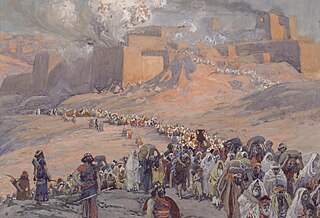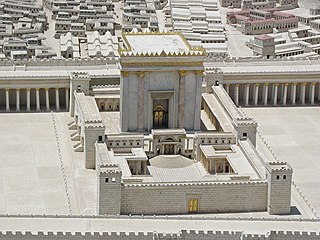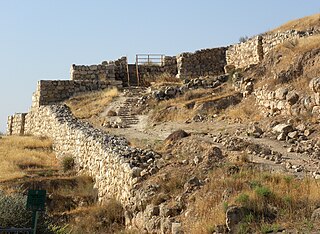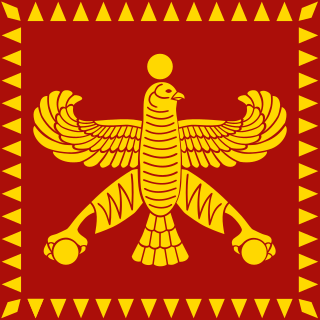Related Research Articles

The Book of Jeremiah is the second of the Latter Prophets in the Hebrew Bible, and the second of the Prophets in the Christian Old Testament. The superscription at chapter Jeremiah 1:1–3 identifies the book as "the words of Jeremiah son of Hilkiah". Of all the prophets, Jeremiah comes through most clearly as a person, ruminating to his scribe Baruch about his role as a servant of God with little good news for his audience.
The Kingdom of Israel and the Kingdom of Judah were two related Israelite kingdoms from the Iron Age period of the ancient Southern Levant. After an emergent and large polity was suddenly formed based on the Gibeon-Gibeah plateau and destroyed by Shoshenq I in the first half of 10th century BCE, a return to small city-states was prevalent in the Southern Levant, but between 950 and 900 BCE another large polity emerged in the northern highlands with its capital eventually at Tirzah, that can be considered the precursor of the Kingdom of Israel. The Kingdom was consolidated as an important regional power by the first half of the 9th century BCE, before falling to the Neo-Assyrian Empire in 722 BCE.

The Kingdom of Judah was an Israelite kingdom of the Southern Levant during the Iron Age. It was centered in the region of Judea, and its capital was Jerusalem. The other Israelite polity, the Kingdom of Israel, lay to the north. Modern Jews are named after and also descended from the Kingdom of Judah.

Two ancient Israelite and Jewish places of worship on the Temple Mount in the Old City of Jerusalem have been called the Temple in Jerusalem, or the Holy Temple. The First or Solomon's Temple was built in 957 BCE and destroyed by the Babylonians in 586 BCE. The Second Temple was completed in 515 BCE and fell to the Roman Siege of Jerusalem in 70 CE.
This article concerns the period 539 BC – 530 BC.

The Babylonian captivity or Babylonian exile is the period in Jewish history during which a large number of Judeans from the ancient Kingdom of Judah were captives in Babylon, the capital city of the Neo-Babylonian Empire, following their defeat in the Jewish–Babylonian War and the destruction of Solomon's Temple in Jerusalem. The event is described in the Hebrew Bible, and its historicity is supported by archaeological and non-biblical evidence.

The Second Temple, also known in its later years as Herod's Temple, was the reconstructed Jewish holy temple that stood on the Temple Mount in the city of Jerusalem between c. 516 BCE and 70 CE. It replaced the First Temple that had been destroyed in 587 BCE by the Neo-Babylonian Empire during its conquest of the Kingdom of Judah; the fallen Jewish kingdom was subsequently annexed as a Babylonian province and part of its populace was held captive in Babylon. Construction on the Second Temple began some time after the conquest of Babylon by the Achaemenid Persian Empire, following a proclamation by the Persian king Cyrus the Great that enabled the Jewish return to Zion. The completion of the Second Temple in the new Achaemenid province of Yehud marked the beginning of the Second Temple period in Jewish history.

Tel Lachish, known in Arabic as Tell ed-Duweir, is the site of an ancient Canaanite and Israelite city, now an archaeological site and an Israeli national park.
The year 587 BC was a year of the pre-Julian Roman calendar. In the Roman Empire, it was known as year 167 Ab urbe condita. The denomination 587 BC for this year has been used since the early medieval period, when the Anno Domini calendar era became the prevalent method in Europe for naming years.

Jeconiah, also known as Coniah and as Jehoiachin, was the nineteenth and penultimate king of Judah who was dethroned by the King of Babylon, Nebuchadnezzar II in the 6th century BCE and was taken into captivity. He was the son and successor of King Jehoiakim, and the grandson of King Josiah. Most of what is known about Jeconiah is found in the Hebrew Bible. Records of Jeconiah's existence have been found in Iraq, such as the Jehoiachin's Rations Tablets. These tablets were excavated near the Ishtar Gate in Babylon and have been dated to c. 592 BCE. Written in cuneiform, they mention Jeconiah and his five sons as recipients of food rations in Babylon.

Tammuz, or Tamuz, is the tenth month of the civil year and the fourth month of the ecclesiastical year on the Hebrew calendar, and the modern Assyrian calendar. It is a month of 29 days, which occurs on the Gregorian calendar around June–July.

The Kings of Judah were the monarchs who ruled over the ancient Kingdom of Judah. According to the biblical account, this kingdom was founded after the death of Saul, when the tribe of Judah elevated David to rule over it. After seven years, David became king of a reunited Kingdom of Israel. However, in about 930 BCE the united kingdom split, with ten of the twelve Tribes of Israel rejecting Solomon's son Rehoboam as their king. The tribes of Judah and Benjamin remained loyal to Rehoboam, and re-formed the Kingdom of Judah, while the other entity continued to be called the Kingdom of Israel, or just Israel.
The history of the Jews and Judaism in the Land of Israel is about the history and religion of the Jews, who originated in the Land of Israel, and have maintained physical, cultural, and religious ties to it ever since. First emerging in the later part of the 2nd millennium BCE as an outgrowth of southern Canaanites, the Hebrew Bible claims that a United Israelite monarchy existed starting in the 10th century BCE. The first appearance of the name "Israel" in the non-Biblical historic record is the Egyptian Merneptah Stele, circa 1200 BCE. During biblical times, two kingdoms occupied the highland zone, the Kingdom of Israel (Samaria) in the north, and the Kingdom of Judah in the south. The Kingdom of Israel was conquered by the Neo-Assyrian Empire, and the Kingdom of Judah by the Neo-Babylonian Empire. Initially exiled to Babylon, upon the defeat of the Neo-Babylonian Empire by the Achaemenid Empire under Cyrus the Great, many of the Jewish elite returned to Jerusalem, building the Second Temple.

In 589 BC, Nebuchadnezzar II laid siege to Jerusalem, culminating in the destruction of the city and its temple in the summer of 587 according to Albright, or 586 BC according to Thiele. In 2004, Rodger Young published an analysis in which he identified 587 BC for the end of the siege, based on details from the Bible and neo-Babylonian sources for related events. Whereas the Nebuchadnezzar Chronicle provides information about the siege of Jerusalem in 597 BC, the only known records of the siege that culminated in Jerusalem's destruction are found in the Hebrew Bible.

The Canaanite “Hebrew” alphabet is a development from the Aramaic alphabet taking place during the Persian, Hellenistic and Roman periods. It replaced the Paleo-Hebrew alphabet which was used in the earliest epigraphic records of the Hebrew language.
The return to Zion is an event recorded in Ezra–Nehemiah of the Hebrew Bible in which the Jews of the subjugated Kingdom of Judah were freed from the Babylonian captivity following the conquest of the Neo-Babylonian Empire by the Achaemenid Persian Empire. After their release, the Persian king Cyrus the Great issued a proclamation known as the Edict of Cyrus that enabled the freed Jews to return to Jerusalem and the Land of Israel, which had begun to function as a self-governing Jewish province.
The Second Temple period in Jewish history lasted between 516 BCE and 70 CE, when the Second Temple of Jerusalem existed. The sects of Pharisees, Sadducees, Essenes, Zealots and early Christianity were formed during this period. The Second Temple period ended with the First Jewish–Roman War and the Roman destruction of Jerusalem and the Temple.

Yehud, also known as Yehud Medinata or Yehud Medinta, was the Aramaic-language name that was retained and used by the Achaemenid Persian Empire for one of its administrative provinces in the region of Canaan. The term was introduced by the Babylonians during their governance of the same region prior to the Persian conquest in 539 BCE.

Jerusalem during the Second Temple period describes the history of the city from the return to Zion under Cyrus the Great to the 70 CE siege of Jerusalem by Titus during the First Jewish–Roman War, which saw both region and city change hands several times. It was the center of religious life for all Jews; even those who lived in the diaspora prayed towards Jerusalem on a daily basis and made pilgrimages during religious festivals. The Pharisees of Second Temple Judaism developed into the Tannaim and Judaism's post-Exilic religious identity as it continues today, and the Hebrew Bible was perhaps canonized, although exactly when this occurred remains disputed. It was also in Jerusalem during the later stages of this period that Christianity was born.
Second Temple Judaism is Judaism between the construction of the Second Temple in Jerusalem, c. 515 BCE, and its destruction by the Romans in 70 CE. The development of the Hebrew Bible canon, the synagogue, Jewish apocalyptic expectations for the future, and the rise of Christianity can all be traced to the Second Temple period.
References
- ↑ "Timeline of Judaism after the Babylonian Exile (538 BCE-70 CE)".
- ↑ Albertz, Rainer. Israel in exile: the history and literature of the sixth century BCE. p. xxi.
- ↑ 1–6 Ezra.
- ↑ Shalem, Yisrael (1997). "Second Temple Period (538 B.C.E. to 70 C.E.): Persian Rule". Jerusalem: Life Throughout the Ages in a Holy City. Ramat-Gan, Israel: Ingeborg Rennert Center for Jerusalem Studies, Bar-Ilan University. Archived from the original on 2018-11-03. Retrieved 2020-01-08.